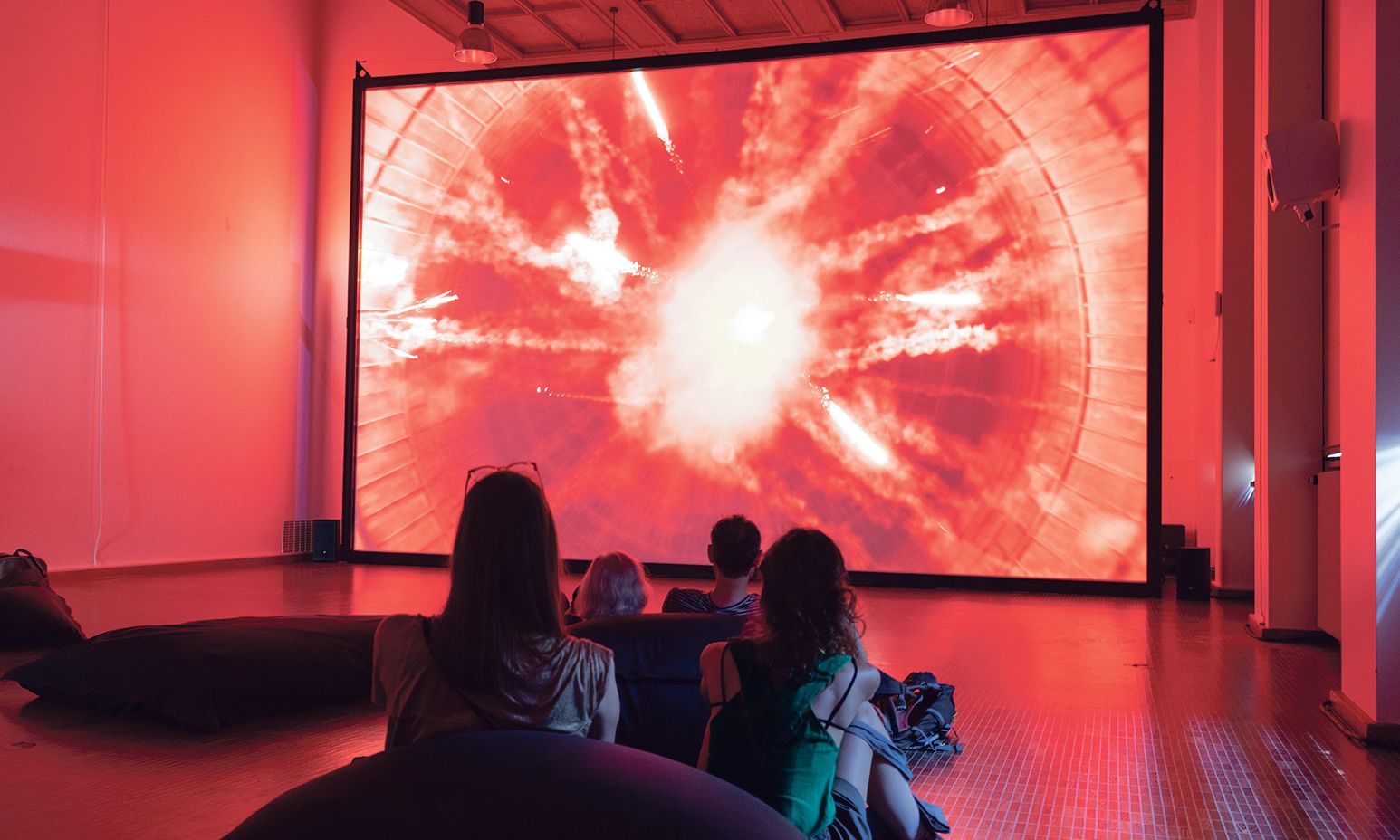Julian Charrière at Kunstmuseum Basel's lecture room David Owens
With its site-specific installations dotted around the city, this year’s Basel Parcours project takes visitors out of the Messeplatz into usually (and, sometimes, still) inaccessible places. From private gardens to libraries to works suspended on bridges and encircled by traffic, this year’s programme—curated by Samuel Leuenberger, the founder and director of the not-for-profit exhibition space SALTS—opens up the geography of the city.
Parcours is free to the public, including fairgoers, but, perhaps more crucially, those living in the city year-round. “This is also a very special moment for people who live in Basel because they can discover places they would never see,” Leuenberger tells us as he walks us around this year’s highlights.
Melike Kara at UBS Geschäftsstelle Aeschenvorstadt David Owens
UBS Geschäftsstelle Aeschenvorstadt
“Kara’s work is centred around building up an archive of Kurdish knowledge. She collects all kinds of imagery: her own photography, family photographs, historical works, things she finds online. You can see some of these photos on these large canvases—on the reverse side are abstract paintings by the artist. These draw on Kurdish tapestry design but they’re also contemporary explorations. Kara, whose work is also concerned with architecture, has created a canopy-like structure which sits underneath the oculus of the UBS lobby, providing a back-light to the databank of imagery plastered across the construction.”
Berlinde De Bruyckere at Haus zum Raben, Picassoplatz David Owens
Haus zum Raben, Picassoplatz
“De Bruyckere’s sculpture of an archangel, Arcangelo III (2023), sits at the end of a rose alley in the private gardens behind the Kuntsmuseum Basel, a space normally closed to the public. A stone cloak shrouds the figure from the Basel sunlight. The artist conceived of this work during the Covid-19 lockdown, sensing that people were down and injured. The fallen, celestial figure symbolises a certain hopelessness.”
Hank Willis Thomas at Kunstmuseum-Kreisel David Owens
Kunstmuseum-Kreisel
“Thomas deals a lot with the symbolism of the raised arm—of defence, of resistance, of hope or success. His work often analyses the media in the US and how these images are being misused and abused—especially around the African American community who face, among other challenges, increased scrutiny and police surveillance. Here, Thomas is playing with the ambiguity of this gesture and what it can mean to different people. This idea is only enhanced by the artist’s use of polished aluminium—a first for him—and the mirror-like quality it lends the work.”
Thomas Houseago at Haus zum Raben, Picassoplatz David Owens
Haus zum Raben, Picassoplatz
“Houseago’s forward-striding work joins De Bruyckere’s to be one of the three works occupying the garden. It is one of those rare and opportune moments where I was able to give space to several artists. This allowed me to depart from the ‘mini-solo-show’ model and simulate a kind of sculpture park. The headless figure is partially dissected, opening it up to the gardens.”
Luís Lázaro Matos at Kunstmuseum Basel's library David Owens
Library, Kunstmuseum Basel
“Matos was interested in the library as the place of research and fantasies. Gay cruising, for example, sometimes happens in libraries. This is brought to life by these site-specific paintings of sexualised, fantasised figures: the academic in glasses, the goat as a symbol of sex—as well as the wall texts, these semi-fictional writings based on flirtatious SMS text exchanges. There’s also the humour of the work: paper-eating goats in a space littered with books. We still have to be quiet in the library but, visually speaking, the work is very loud.”
Julian Charrière at Kunstmuseum Basel's lecture room David Owens
Lecture room, Kunstmuseum Basel
“This is only the second time this film has been on show, having been debuted at a solo exhibition at Germany’s Langen Foundation. Its inclusion in Parcours therefore gives the installation its first large, international audience. What we’re looking at is footage from a drone flying over abandoned and disused coal-mining areas in the German region of Rhine-Westphalia. So we’re seeing the slightly slowed footage of fireworks at night, recorded backwards. The background is occasionally pitch-black but when the fireworks explode it illuminates the ruin of the area, making visible the wreck we leave behind and the damage we do to the earth.”

